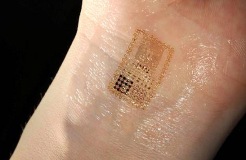The development of low power electronics and devices that are wearable, epidermal, edible or even implantable, will be debated at the IDTechEx event in Boston, USA next month. One company involved, MC10, of Cambridge, Massachusetts is heading efforts to commercialise the technology dubbed ‘smart skin’.
Currently, the use of implanted medical devices for long-term monitoring of medical conditions presents a challenge in terms of a renewable power source. Such devices need a self-sufficient power source that does not interact with its surroundings, and batteries are impractical due to their need for replacement.
Smart skin is an “epidermal electronic system”, which was developed with funding by the National Science Foundation and the US Air Force. The device contains micro-circuitry such as transistors, sensors, transmitters and receivers that can get wrinkled, are bendable and stretchable, just like real skin, yet allowing damage-free function of all components.
The technology would allow wearers freedom of movement, avoiding the obtrusive, uncomfortable methods, such as using adhesive tapes and wires to attach devices to people. The main reason is that smart skin is only 50 microns thick and light enough to stay attached to real skin without glue or adhesive, through surface forces.
Power consumption is said to be so low that no battery will be needed for most applications. The device can harvest energy from ambient sources, via miniaturised solar cells or the movements of its wearer.
The human body is an excellent source of thermal as well as mechanical energy. Thermal gradients are present on the surface of the skin and may be used for external skin-mounted sensors. Vibrational energy scavenging is also a viable source of renewable energy and devices powered by the human heartbeat have been created. Electricity to power implanted medical devices can be harvested from the pulse of a blood vessel, a gentle breeze, or the motion from walking.
The CEO of MC10, David A Icke, will be discussing smart skin developments at the upcoming IDTechEx event, Energy Harvesting & Storage and Wireless Sensor Networks USA. Also talking at the event is Dr Elizabeth K Reilly of Exponent Engineering and Scientific Consulting, who will be discussing energy scavenging and battery power for long term medical monitoring. Reilly’s past research at the University of California, Berkeley focused on the development of microscale energy scavenging devices while Exponent provides solutions to solve a variety of challenges associated with device design, performance, and interaction with their environment including cardiovascular, neurovascular, peripheral endovascular, pulmonary, tracheal-bronchial, biliary and renal (CVNP) implantable devices.
Exhibiting at the show is Zarlink Semiconductor, a company that delivers mixed-signal chip technologies for communication and medical applications and ultra low-power radios enabling new wireless medical devices and therapies. Zarlink is involved in the TIPS (Thin Interconnect Package Stack) Project which concentrates on the creation of complex electronics in ultra-thin stacked packages with a maximum layer thickness of 0.10 mm. Zarlink’s ultra-low power RF system-on-chip solution allows the integration of wireless functionality into advanced sensor and data streaming applications without impacting battery life with applications including wireless implants and ingestible low-power sensors.
For more information on the conference and exhibition, 15-16 November in Boston, Massachusetts, go to: www.IDTechEx.com/Boston
(Photo: Prof John A Rogers, University of Illinois)










